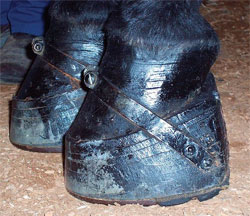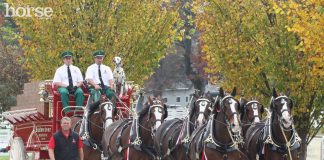No one in the horse world would come out in favor of soring. In that respect, it’s not exactly controversial; everyone is against it, at least publicly. But it’s still happening. We’re still discussing it more than 40 years after the passage of the Horse Protection Act, which made soring illegal. The court of public opinion (and federal law) are unambiguous in their condemnation of this practice, but there are still trainers who think that it’s somehow okay to abuse horses in this way to get a desired result, as long as they don’t get caught.
 |
| This shoeing job isn’t actually illegal under the Horse Protection Act, although there are plenty of horse welfare advocates who say that it should be. Photo: Todd Behre/USDA via Wikimedia Commons |
If you encounter any discussion on the topic on the Internet or in the real world, you’ll typically find a couple of stock arguments from defenders of the Walking Horse show industry. First, they’ll say that soring is nearly (or completely) eradicated, no one does it anymore, but the inspectors find violators because they are corrupt and/or don’t know anything about horses. Unfortunately, this is false, as was proved in well-publicized hidden-camera footage that came out last year. And yes, it’s possible that there are only a few bad seeds in the industry still clinging to this practice, but even if one trainer is soring their horses, that’s one trainer too many.
The other argument is something along the lines of, “other breeds/disciplines do worse stuff to their horses, but I don’t see you complaining about them!” It’s true that horse abuse occurs to some degree across all disciplines, but this argument is just a deflection. Even if other disciplines had worse forms of abuse, that wouldn’t make soring any less objectively bad. And it’s not as if people aren’t out there speaking out against other forms of horse abuse. You can be against all forms of abuse, but sometimes you have to pick one at a time for the sake of discussion or meaningful action.
Soring has been the topic of plenty of articles in equestrian publications over the years. Here’s the intro paragraph to one such article, and I want you to guess when it was published.
Horse business and sharp practice have not traditionally been divorced. But far uglier than mere chicanery is the widespread and longstanding practice of purposeful injury to that pleasant riding animal, the Tennessee Walking Horse. The torture, known and until recently condoned by inaction, is rarely punished legally. Reprimand from the horse world itself amounts to little more than a slap on the wrist. Only hostile public opinion to add force to the overdue wave of indignation against abuses will limit, if not stop, them during many of the major shows still ahead.
Last month? Last year? A decade ago? Around the time when the Horse Protection Act was passed in 1970?
Actually, this is the opening paragraph of an article titled “Woe for Walkers” and published in Sports Illustrated in 1956. That’s 14 years before the HPA and 57 years before today, but other than the style of language (we so rarely use the phrase, “pleasant riding animal” these days), it could have been written yesterday. The biggest change may be that trainers are now more cognizant of the importance of good P.R. on the subject. For example, this paragraph from the same article describes an ad that Walking Horse trainers of this century would know better than to produce:
The desired effect—that of making him walk gingerly—is so generally obtained by hurting the horse’s feet that it is possible to read a proud advertisement like this for a mare touted as walking “with the sore lick without being sore. Examine those dainty, fast-flying feet and not a hair is out of place, no nails are driven to quick her, no gadgets and no tricks. Just pure, natural walking ability….”
No nails driven to quick her? Great! That’s definitely in the “pro” column of my horse-shopping checklist.
I came across this article thanks to the anti-soring group, Friends of Sound Horses (FOSH) which has compiled an extensive list of published materials on the topic of soring from 1956 article through the present day. It’s interesting to read the progression of Walking Horse welfare written as current events rather than a historical overview. But it’s also depressing that after all these years and all this discussion, all we seem to be able to show for it are sneakier methods of soring to avoid detection.
I wish I could conclude with my proposal for a solution to the problem of show-horse abuse, but I don’t have one. If there were a simple answer, I suppose we would have figured that out back in 1956, and we wouldn’t even have to talk about it anymore.
Back to The Near Side






sad that people can’t learn and change to better training methods torture passed on generation to generation